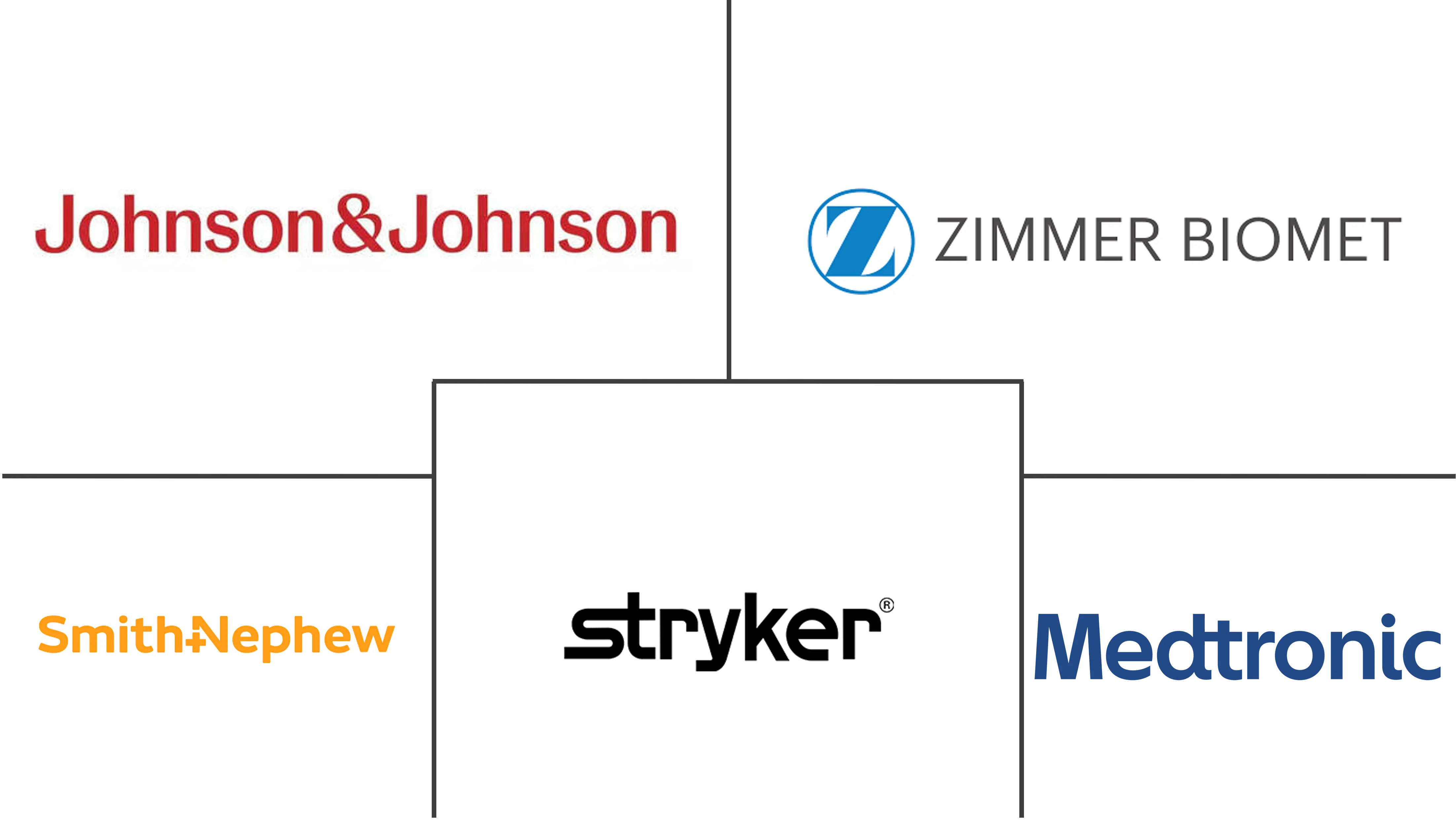Bone Grafts And Substitutes Market Size and Share
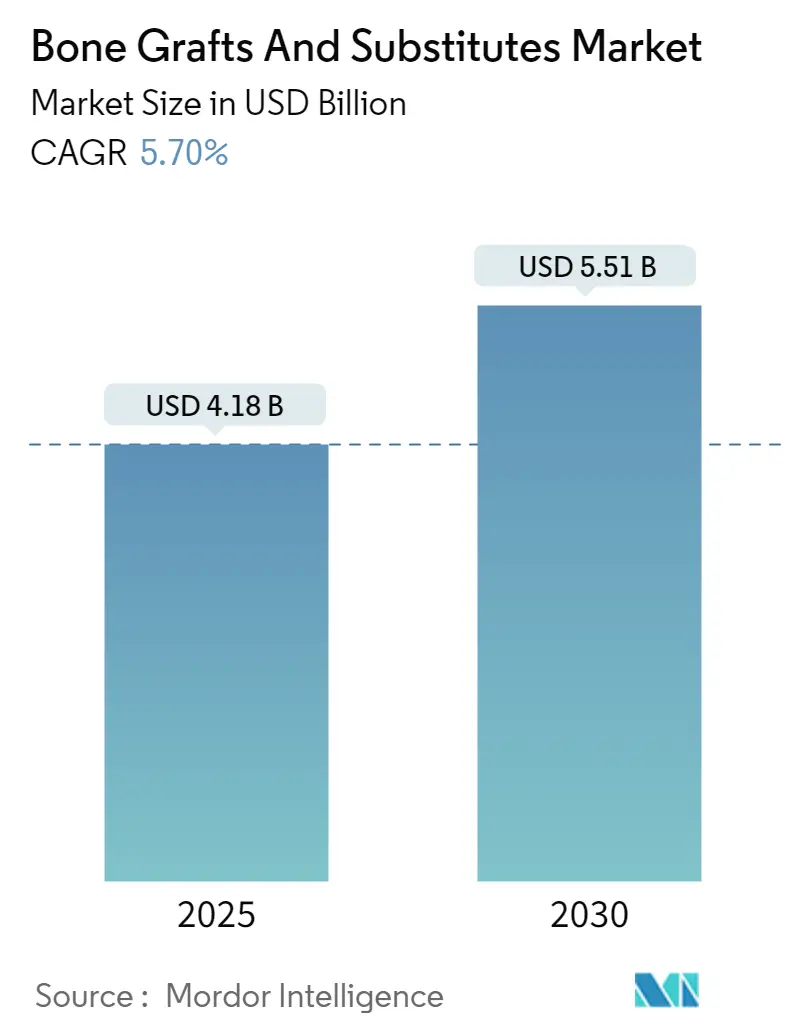
Bone Grafts And Substitutes Market Analysis by Mordor Intelligence
The bone grafts and substitutes market size reached USD 4.18 billion in 2025 and is forecast to climb to USD 5.51 billion by 2030, reflecting a 5.70% CAGR over the period. Rapid progress in nanoscale 3-D printing, breakthroughs in bioactive glass and calcium-phosphate ceramics, and wider acceptance of cell-based matrices are shifting surgeon preference away from traditional autografts toward precision-engineered alternatives. Procedure volumes in spinal fusion and joint reconstruction continue expanding, with minimally invasive techniques enabling earlier interventions that drive steady product demand. Regulatory support is also accelerating innovation; FDA breakthrough designations awarded to new grafts shorten commercialization timelines while signaling clinical value. Industry participants layer competitive advantages around proprietary surface technologies, porous architectures, and patient-specific design—all aimed at faster fusion, lower complication rates, and more predictable healing.
Key Report Takeaways
- By product type, allografts held 42.67% of bone grafts and substitutes market share in 2024 and are expanding at a 6.24% CAGR to 2030.
- By material, calcium-phosphate ceramics commanded 44.34% share of the bone grafts and substitutes market size in 2024, while bioactive glass is set to advance at a 6.48% CAGR through 2030.
- By application, spinal fusion accounted for 55.10% of the bone grafts and substitutes market size in 2024 and is forecast to widen at a 6.72% CAGR to 2030.
- By end user, hospitals controlled 61.23% of bone grafts and substitutes market share in 2024, whereas ASCs post the highest projected CAGR at 6.98% through 2030.
- By geography, North America commanded 42.23% of 2024 global revenue, whereas Asia-Pacific is rising at a 7.24% CAGR through 2030.
Global Bone Grafts And Substitutes Market Trends and Insights
Driver Impact Analysis
| Driver | (~) % Impact on CAGR Forecast | Geographic Relevance | Impact Timeline |
|---|---|---|---|
| Increasing spinal-fusion & joint-reconstruction volumes | +1.2% | Global, with concentration in North America & Europe | Medium term (2-4 years) |
| Rising geriatric population with osteoporosis & trauma risk | +1.8% | Global, particularly APAC and North America | Long term (≥ 4 years) |
| Technological advances in synthetic & cell-based matrices | +0.9% | North America & Europe, expanding to APAC | Medium term (2-4 years) |
| Shift from autografts to off-the-shelf substitutes | +0.7% | Global, led by North America and Europe | Short term (≤ 2 years) |
| 3-D printed, patient-specific scaffolds enable complex reconstructions | +0.6% | North America & Europe | Long term (≥ 4 years) |
| Ambulatory-surgery-center demand for minimally-invasive delivery kits | +0.5% | North America, expanding to Europe and APAC | Medium term (2-4 years) |
| Source: Mordor Intelligence | |||
Increasing Spinal-Fusion & Joint-Reconstruction Volumes
Posterior cervical fusions for deformity grew at a 16.5% CAGR versus 9.7% for standard cases, confirming surgeon confidence to tackle complex anatomy with modern implants. ASCs expect orthopedic outpatient cases to climb 13% this decade, making rapid-setting grafts essential to same-day discharge targets. High throughput combined with heightened complexity shifts purchasing toward bone graft substitutes that reduce harvest-site morbidity, shorten operating time, and integrate seamlessly with interbody cages. Surgeons increasingly treat graft substitutes not as secondary fillers but as frontline enablers of workflow efficiency and enhanced patient recovery.
Rising Geriatric Population with Osteoporosis & Trauma Risk
Projected lower-limb arthroplasties in Colombia illustrate global momentum, rising to 39,270 procedures by 2050 at a 5.54% CAGR, driven primarily by aging female cohorts. Elderly patients present diminished osteogenic capacity and higher infection risk, raising the bar for graft bioactivity and antimicrobial performance. Medicare joint-arthroplasty reimbursements slid substantially from 2013 to 2021 despite higher beneficiary counts, forcing health systems to prioritize cost-effective grafts that outperform autografts without inflating episode costs, according to a September 2024 analysis of the Medicare Part B database published in the Journal of Orthopaedic Experience & Innovation.
Calcium-doped titanium surfaces show promise in minimizing infection by modulating fibrinogen adsorption and bacterial adherence, which is vital in older populations with compromised immunity. Together these demographic and clinical pressures propel demand for bone graft substitutes that pair osteoinductivity with robust antimicrobial defenses.
Technological Advances in Synthetic & Cell-Based Matrices
Coral-inspired grafts created at Swansea University heal in 2-4 weeks and dissolve fully over 6-12 months, mirroring natural bone remodeling. University of Sydney scientists pushed nanoscale 3-D printing to replicate grain size and porosity of cancellous bone, achieving mechanical strength akin to native tissue. Cell-viable matrices such as Osteocel Plus demonstrate improved fusion but await FDA clarity for engineered MSC content, which could unlock next-level biologics once regulatory pathways settle. Material science gains are increasingly married to additive manufacturing, enabling tailored stiffness, degradation, and bioactive signaling that exceed autograft benchmarks. These converging capabilities cement a technology-driven growth arc for the bone grafts and substitutes market.
3-D Printed, Patient-Specific Scaffolds Enable Complex Reconstructions
Use of individualized hydroxyapatite implants in maxillofacial repair delivered favorable outcomes across 13 patients, highlighting clinical maturation of patient-specific grafts. Dual-thermal, shape-memory composites permit minimally invasive delivery that expands in situ and offers photothermal tumor ablation, serving both reconstructive and oncologic objectives. High-porosity (>50%) scaffolds with 300-400 µm pore sizes maximize nutrient diffusion, accelerating osteogenesis across long-bone defects. Tri-element-doped constructs add antibacterial potency while preserving osteoconduction, reducing postoperative infection risk. Patient-specific designs thus redefine the art of reconstruction by combining perfect anatomical fit with multifunctional biological performance.
Restraint Impact Analysis
| Restraint | (~) % Impact on CAGR Forecast | Geographic Relevance | Impact Timeline |
|---|---|---|---|
| High cost & patchy reimbursement for premium grafts | -0.8% | Global, particularly acute in emerging markets | Short term (≤ 2 years) |
| Disease-transmission / immune-response risk with allo- & xenografts | -0.5% | Global, with regulatory variations by region | Medium term (2-4 years) |
| Medical-grade calcium-phosphate supply bottlenecks | -0.4% | Global, concentrated in manufacturing hubs | Short term (≤ 2 years) |
| Nano-ceramic-particle inflammation triggering tougher regulation | -0.3% | North America & Europe, expanding globally | Long term (≥ 4 years) |
| Source: Mordor Intelligence | |||
High Cost & Patchy Reimbursement for Premium Grafts
Basic synthetic materials cost USD 46.2–140, while premium grafts exceed reimbursement caps, leading facilities to limit use to complex cases. Coverage for stem-cell-enhanced products remains conditional, intensifying uncertainty for innovators navigating evidence-based reimbursement hurdles. Regional variability compounds the issue; U.S. Northeast saw the steepest payment declines despite the highest baseline rates, underscoring geographic inconsistency in economic viability.
Disease-Transmission / Immune-Response Risk with Allo- & Xenografts
FDA records list 62 adverse BMP-related events—nearly half requiring revision surgery—driving heightened scrutiny of biological grafts. Reviews investigating BMP-2 carcinogenicity produce mixed conclusions, sustaining clinical caution despite lack of definitive evidence of tumor initiation. Tissue banks employ advanced viral-inactivation protocols, yet fear of immune response and transmission keeps synthetic alternatives attractive. Xenografts undergo extensive deproteinization to curb immunogenicity but still face regulatory headwinds. Collectively, safety concerns reinforce preference for ceramics, composites, and emerging synthetic matrices in the bone grafts and substitutes market.
Segment Analysis
By Product Type: Allografts Maintain Leadership Despite Synthetic Innovation
Allografts captured the largest slice of bone grafts and substitutes market share at 42.67% in 2024, supported by clinician familiarity and strong osteoinductive profiles[1]Source: Medtronic, “Grafton Bone Graft,” medtronic.com. Hospitals value their supply predictability, while tissue banks refine processing to safeguard biologic potency and viral safety. The bone grafts and substitutes market size for allografts is projected to rise steadily, propelled by fiber-based demineralized matrices that deliver improved handling and minimal donor-site morbidity. Synthetic grafts are closing the gap through nano-engineered surfaces and controlled degradation, and cell-based matrices post the fastest growth as regulatory clarity improves.
Competitive dynamics center on differentiation by specific procedure. Xenografts hold niche traction in dental indications that benefit from non-resorbable properties. Novel non-resorbable allografts extend longevity, easing revision anxiety in load-bearing zones. Cryopreserved viable bone matrices target premium clinical segments after Enovis and Ossium Health linked distribution reach with biologic innovation. Each product category therefore positions itself around a discrete clinical need set—safety, biological potency, or ease of use.
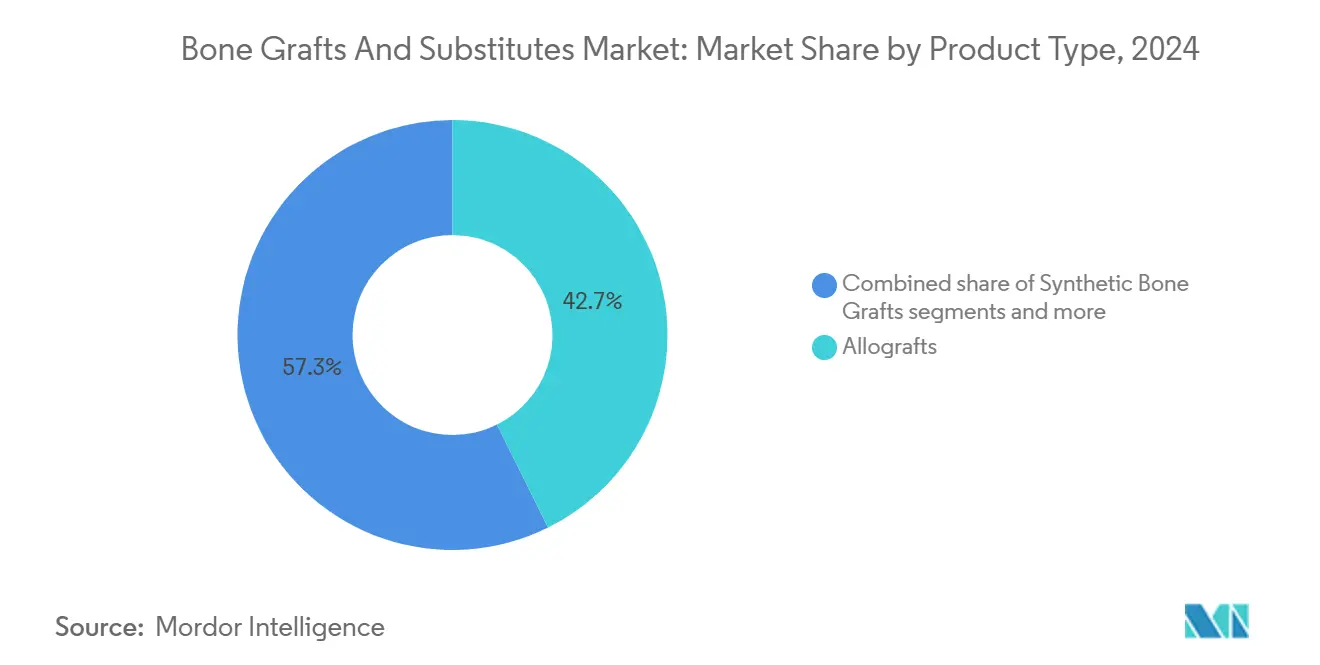
Note: Segment shares of all individual segments available upon report purchase
By Material: Calcium-Phosphate Ceramics Lead While Bioactive Glass Accelerates
Calcium-phosphate ceramics represented 44.34% of bone grafts and substitutes market share in 2024 thanks to predictable biocompatibility and established regulatory paths. Advances in porosity tuning and silicon doping improve mechanical strength while accelerating osseointegration. The bone grafts and substitutes market size attached to bioactive glass grows fastest as newer formulations manage degradation kinetics and heighten osteostimulation. Polymer-based options remain in early adoption, valued for elasticity and drug-release potential in trauma settings. Composite matrices combining hydroxyapatite and collagen now rival iliac crest graft fusion rates while eliminating harvest pain[2]Source: Yu Matsukura, “Hydroxyapatite/Collagen Composite Graft for ACDF,” BMC Musculoskeletal Disorders, biomedcentral.com. Supply reliability also shapes material selection; calcium sulfate modifications attempt to slow resorption without sacrificing structural integrity.
By Application: Spinal Fusion Dominance Drives Innovation Focus
Spinal fusion remained the largest application, covering 55.10% of bone grafts and substitutes market size in 2024. The segment attracts the bulk of R&D funding as companies chase materials that shorten fusion times and fit minimally invasive cages. Synthetic peptide-based grafts such as i-Factor achieved 69% success in cervical fusions, surpassing autograft outcomes and accelerating clinical adoption. Trauma and craniomaxillofacial follow, buoyed by 3-D printed implants that conform to complex geometries, while dental grafting sustains steady uptake through rising implant volumes and needs for predictable resorption.
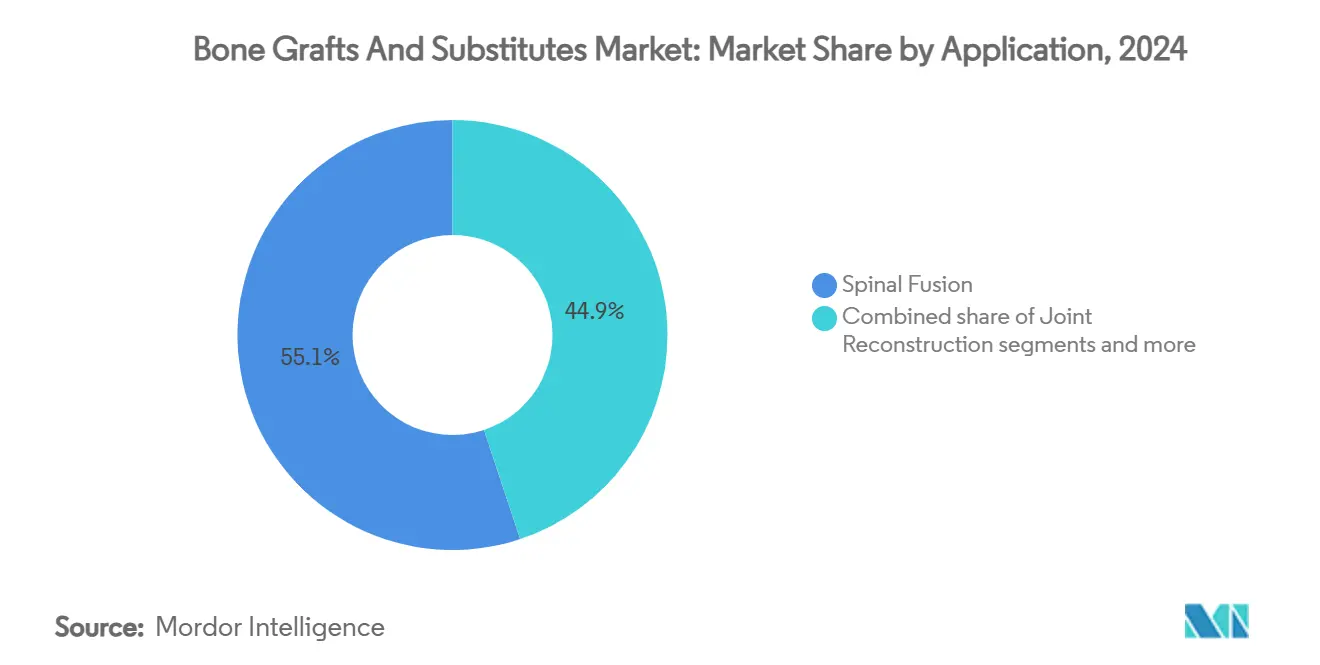
Note: Segment shares of all individual segments available upon report purchase
By End User: Hospitals Lead While ASCs Gain Momentum
Hospitals controlled 61.23% of bone grafts and substitutes market share in 2024, benefiting from multidisciplinary teams and capacity for complex orthopedics. Yet ASCs chart the most rapid expansion as outpatient protocols reshape payer incentives. Grafts optimized for syringe delivery and rapid handling allow surgeons to maintain throughput without compromising union quality. Specialty orthopedic clinics tailor procurement to standardized protocols, whereas dental clinics lean toward alloplastics like OsteoGen to circumvent donor-derived risks.
Geography Analysis
North America held 42.23% share in 2024, anchored by high procedure volumes, broad insurance coverage, and high surgeon comfort with premium products. Posterior cervical fusions for deformity continue to outpace other segments, underscoring demand for grafts that perform in challenging biomechanics. FDA breakthrough programs, such as Renovos’s gel, channel innovation swiftly into operating rooms.
Europe stands second, characterized by rigorous evidence requirements and a penchant for ceramic and composite solutions. Germany and the United Kingdom invest heavily in biomaterials research, seeding a pipeline of glass-ceramic hybrids with controlled degradation profiles. Southern Europe’s aging demographics sustain demand even as cost containment exerts downward price pressure.
Asia-Pacific records the fastest CAGR at 7.24%, driven by China’s hospital expansion, India’s burgeoning medical tourism, and Japan’s super-aged populace. Governments increase orthopedic funding, while local manufacturers scale additive-manufacturing capacity to lower import dependency. Wider insurance penetration and surgeon training programs further lift adoption of next-generation bone graft substitutes.

Competitive Landscape
Market leadership remains with diversified device majors, Medtronic, Stryker, and Johnson & Johnson, each leveraging bundled portfolios and global distribution. Medtronic’s Adaptix Interbody System, enabled by Titan nanoLOCK surface microtopography, exemplifies in-house advancement combined with targeted M&A. Stryker’s Augment rhPDGF-BB product enhances ankle fusion, illustrating niche innovation that extends beyond spine.
Challenger firms pursue specialization: Renovos targets injectable gels; Cerapedics focuses on peptide-mineral constructs; Enovis partners for cryopreserved cell-viable matrices. Strategic collaboration intensifies as incumbents scout acquisition candidates with additive manufacturing or biologics expertise. Pricing competition remains secondary to performance differentiation, though hospital value-analysis committees increasingly weigh long-term fusion success against upfront graft cost.
Bone Grafts And Substitutes Industry Leaders
-
Medtronic Plc
-
Zimmer Biomet
-
Stryker Corporation
-
Johnson and Johnson
-
Smith+Nephew
- *Disclaimer: Major Players sorted in no particular order
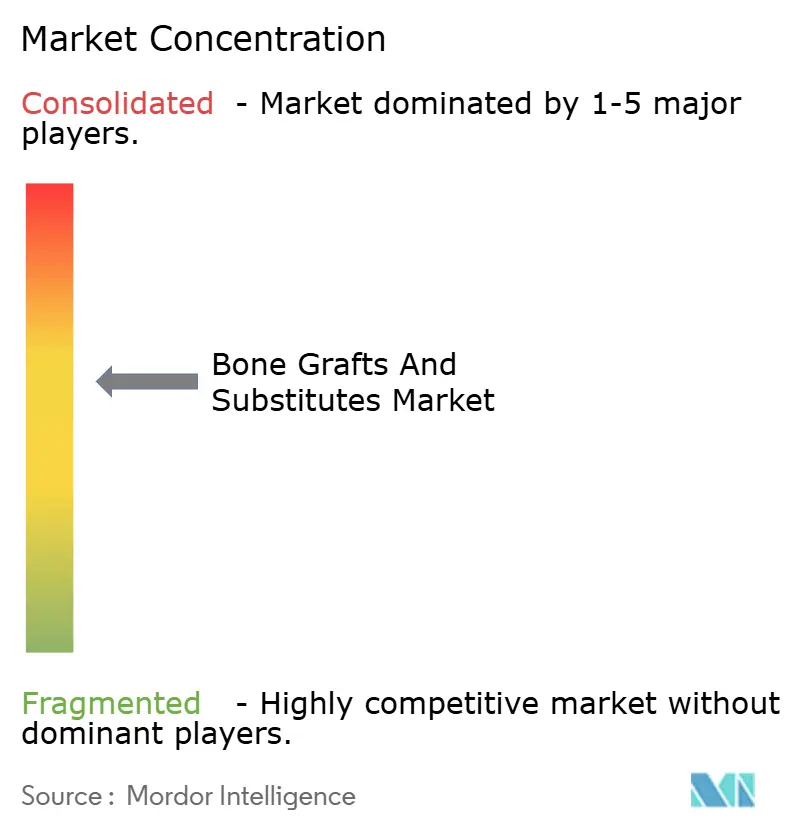
Recent Industry Developments
- July 2025: SurGenTec expanded indications for OsteoFlo HydroFiber bone grafting product
- April 2025: University of Sydney achieved nanoscale 3-D printing breakthrough for synthetic bones
Global Bone Grafts And Substitutes Market Report Scope
As per the scope of the report, bone graft is a surgical procedure in which diseased or damaged bones are repaired and rebuilt using transplanted bones. These are implantable materials that promote bone healing, bone formation, and osseous reconstruction due to their osteoconductive, osteogenic, and osteoinductive properties. Bone grafts can also be used to fill voids in case of the absence of bones or to provide structural stability.
The bone grafts and substitutes market is segmented by product type, material, application, end user, and geography. By product type, the market is categorized into allografts, synthetic bone grafts, demineralized bone matrix (DBM), cell-based matrices, and xenografts. By material, it is segmented into calcium-phosphate ceramics, bioactive glass, polymer-based grafts, and composite materials. By application, the market is divided into spinal fusion, trauma and craniomaxillofacial, joint reconstruction, dental bone grafting, foot & ankle and others. By end user, the segmentation includes hospitals, specialty clinics, ambulatory surgical centers, and dental clinics. Geographically, the market is analyzed across North America, Europe, the Asia-Pacific region, the Middle East & Africa, and South America. The market report also covers the estimated market sizes and trends for 17 countries across major regions globally. For each segment, the market size and forecast are provided in terms of value (USD).
| Allografts |
| Synthetic Bone Grafts |
| Demineralized Bone Matrix (DBM) |
| Cell-based Matrices |
| Xenografts |
| Calcium-phosphate ceramics |
| Bioactive glass |
| Polymer-based grafts |
| Composite materials |
| Spinal Fusion |
| Trauma & Craniomaxillofacial |
| Joint Reconstruction |
| Dental Bone Grafting |
| Foot & Ankle |
| Others |
| Hospitals |
| Specialty Clinics |
| Ambulatory Surgical Centers |
| Dental Clinics |
| North America | United States |
| Canada | |
| Mexico | |
| Europe | Germany |
| United Kingdom | |
| France | |
| Italy | |
| Spain | |
| Rest of Europe | |
| Asia-Pacific | China |
| India | |
| Japan | |
| South Korea | |
| Australia | |
| Rest of Asia-Pacific | |
| South America | Brazil |
| Argentina | |
| Rest of South America | |
| Middle East and Africa | GCC |
| South Africa | |
| Rest of Middle East and Africa |
| By Product Type | Allografts | |
| Synthetic Bone Grafts | ||
| Demineralized Bone Matrix (DBM) | ||
| Cell-based Matrices | ||
| Xenografts | ||
| By Material | Calcium-phosphate ceramics | |
| Bioactive glass | ||
| Polymer-based grafts | ||
| Composite materials | ||
| By Application | Spinal Fusion | |
| Trauma & Craniomaxillofacial | ||
| Joint Reconstruction | ||
| Dental Bone Grafting | ||
| Foot & Ankle | ||
| Others | ||
| By End User | Hospitals | |
| Specialty Clinics | ||
| Ambulatory Surgical Centers | ||
| Dental Clinics | ||
| By Geography | North America | United States |
| Canada | ||
| Mexico | ||
| Europe | Germany | |
| United Kingdom | ||
| France | ||
| Italy | ||
| Spain | ||
| Rest of Europe | ||
| Asia-Pacific | China | |
| India | ||
| Japan | ||
| South Korea | ||
| Australia | ||
| Rest of Asia-Pacific | ||
| South America | Brazil | |
| Argentina | ||
| Rest of South America | ||
| Middle East and Africa | GCC | |
| South Africa | ||
| Rest of Middle East and Africa | ||
Key Questions Answered in the Report
What is the projected value of the bone grafts and substitutes market by 2030?
Forecasts place the market at USD 5.51 billion by 2030, reflecting a 5.70% CAGR from 2025.
Which product type currently leads sales of bone graft substitutes?
Allografts lead with 42.67% share in 2024 due to surgeon familiarity and reliable osteoinductive performance.
Why are ambulatory surgical centers important to future demand?
ASCs are projected to grow orthopedic outpatient volumes 13% this decade, requiring grafts that support same-day discharge and streamlined handling.
Which region is expanding the fastest for bone graft substitutes?
Asia-Pacific shows the highest CAGR at 7.24% through 2030, driven by aging populations and widening healthcare access.
How are new technologies improving graft performance?
Nanoscale 3-D printing, bioactive glass innovation, and cell-based matrices enable patient-specific scaffolds with faster fusion and reduced complication risk.
Page last updated on:
